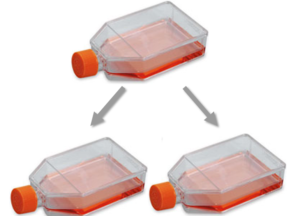Cell Subculture Protocol
Growing LNCaP Cell Line in vitro

LNCaP cells are epithelial cells with weakly-adherent qualities. They grow well in vitro, albeit slowly, and can be grown in aggregates or as individual cells. The cells attach lightly to the surface of the flask, they acidify the complete medium in which they are grown and do not become confluent. Rather than becoming confluent, LNCaP cells tend to aggregate instead of forming a monolayer. In semisolid media the cells form spherical clones.
The LNCaP cell line is sensitive to the hormones estrogen and androgen, commonly used to modulate its growth. LNCaP cells are androgen dependent and will not grow without the presence of this hormone, although the cells can be transformed to androgen-independent clones. Conversely, LNCaP cells grown in culture are resistant to an environment rich in human fibroblast interferon.
Tips
- Confluency
- Cells in flasks like to be grown in an environment that falls within certain population ranges. Too few cells in the flask results in the cells stop growing due to lack of cell contact. However, too many cells in the flask will cause the cells to stop proliferating due to lack of available room to grow. In order to maintain cells in exponential growth, flask confluency should be maintained between 30-90%. This is similar to the Goldilocks story.
- Thawed Aliquot
- Thawed cells are extremely fragile due to DMSO and freezing conditions. The cells should be thawed in less than 1 minute. Also, do not pellet the cells by centrifugation to remove freezing media and DMSO. Rather, the DMSO will be diluted by adding the thawed aliquot directly to a flask containing warm media.
- Passage Number
- Passage numbers should be strictly recorded on the flask and not allowed to reach high numbers. Cells undergo genotypic variations and genetic drift with high passage number. The end result will be hard to transfect cells, slow growing cells and data sets that cannot be repeated due to the changing genetics of the cell.
LNCaP Cell Culture Protocol
The base culture medium for LNCaP is RPMI-1640 with 10% FBS. Cells should be maintained in an incubator at 37°C with 5% CO2.
To subculture:
- Rinse cells with 0.25% Trypsin/0.53mM EDTA
- To a T75 flask, add 1-2 mL of trypsin-EDTA to the flask and observe for cell layer detachment under an inverted microscope. Detachment should occur within 3-12 minutes. Do not agitate cells during this process as agitation encourages clustering of cells. If cells are not detaching, place in incubator for 5 minutes to facilitate dispersal.
- Neutralize the trypsin-EDTA by adding complete media (containing FBS) at a volume of 4x the volume of trypsin-EDTA added; centrifuge the cells and remove the supernatant
- Add 6-8 mL of growth medium and gently aspirate cells with pipette
- Add aliquots of cell suspension to culture vessels
- incubate at 37°C in 5% CO2
Troubleshooting Subculture Procedures
Low cell viability after passaging cells
- Reduce harsh pipetting during cell collection
- Cells may have been exposed to the trypsin too long; only leave trypsin on cells long enough for cell detachment to occur
Determine Cell Viability
- Cell viability is the calculation of the number of living cells in the total number of cells. There are now commercially available alternatives to the historical method, but trypan blue exclusion is the method commonly used in the lab setting. Trypan blue dye is added to a cell suspension and visualized on a hemocytometer. Any non-viable cell in the suspension will have a weakened cell membrane that allows trypan blue to pass through the membrane. When visualizing, both the total cell population and trypan blue stained cells are counted. Healthy cells are a suspension composed of greater than 90% viable cells according to the following equation:
- % viable cells = [ 1 – (number of blue cells/number of total cells) ] * 100
Cells are difficult to detach
- Ensure the flask/dish was washed completely with sterile 1x PBS prior to addition of the dissociation agent; two 1x PBS washes can be used
- Confluency was too high, resulting in tight cell-to-cell junctions and preventing trypsin from reaching the cell interface; resolve by subculturing the cells before reaching high confluency
- Use a higher concentration of trypsin and incubate the flask at 37°C while waiting for detachment activity
Links
Stable Cell Line Generation Services
List of Companies Offering Lab Services
LNCaP Cells │ Cell Subculture Protocol │ LNCaP Transfection │ Get LNCaP Transfection Reagent